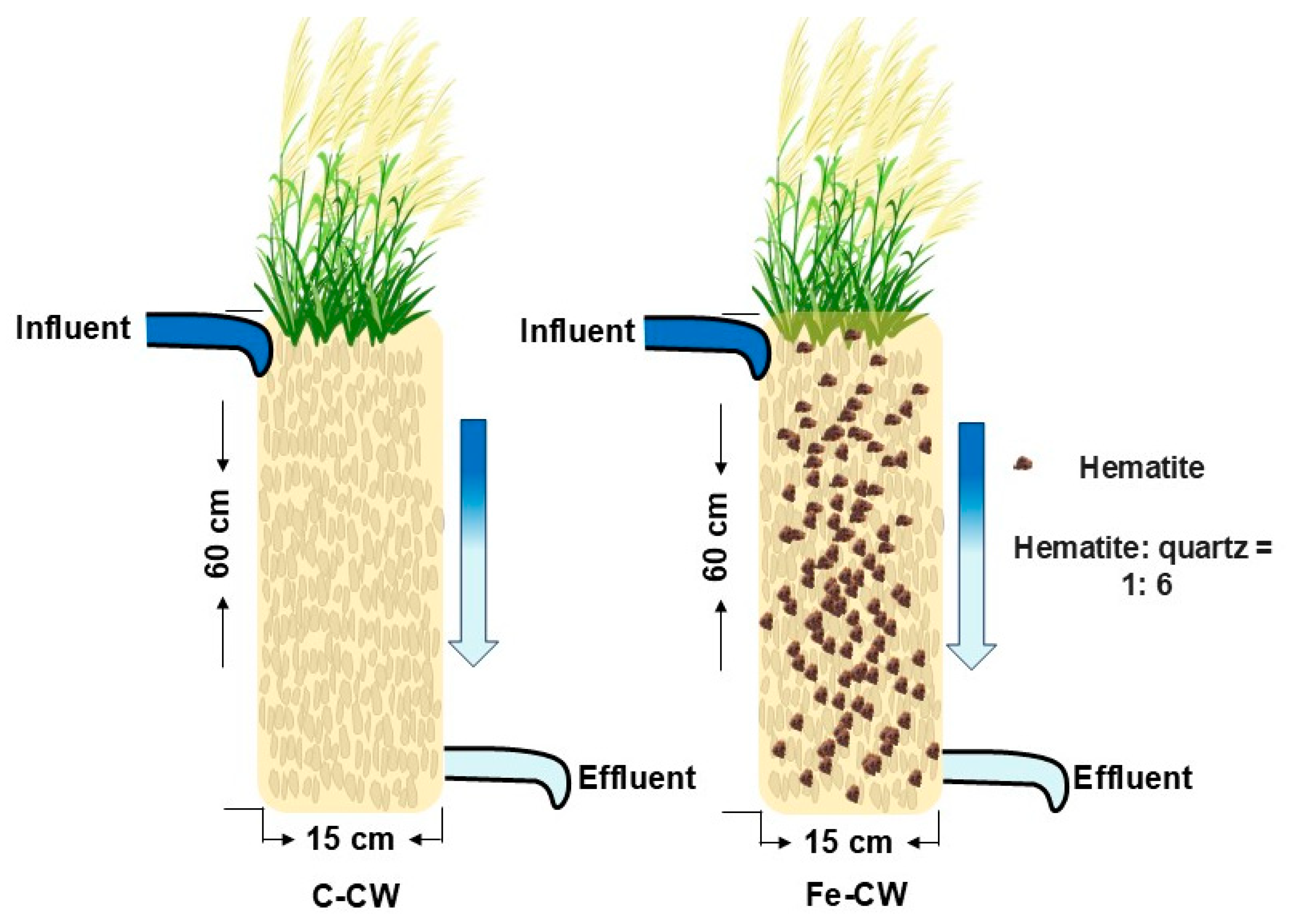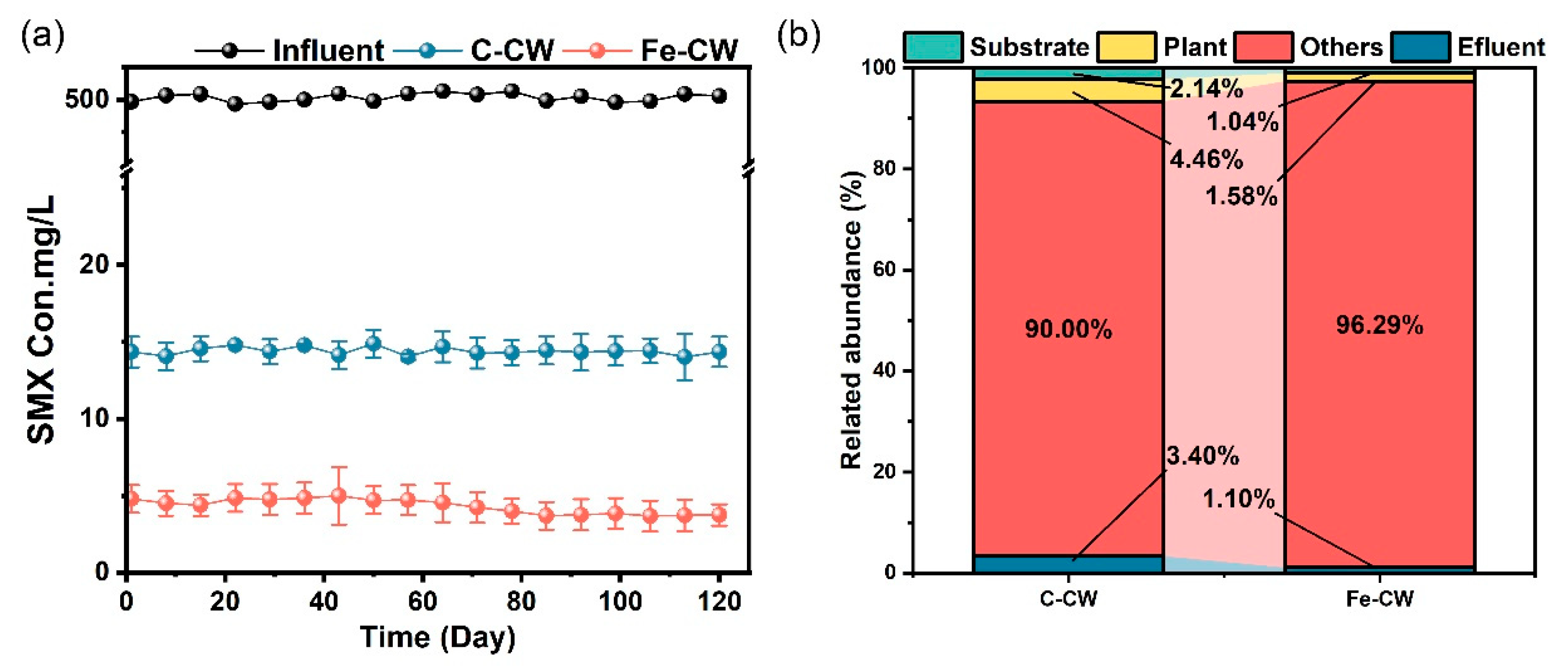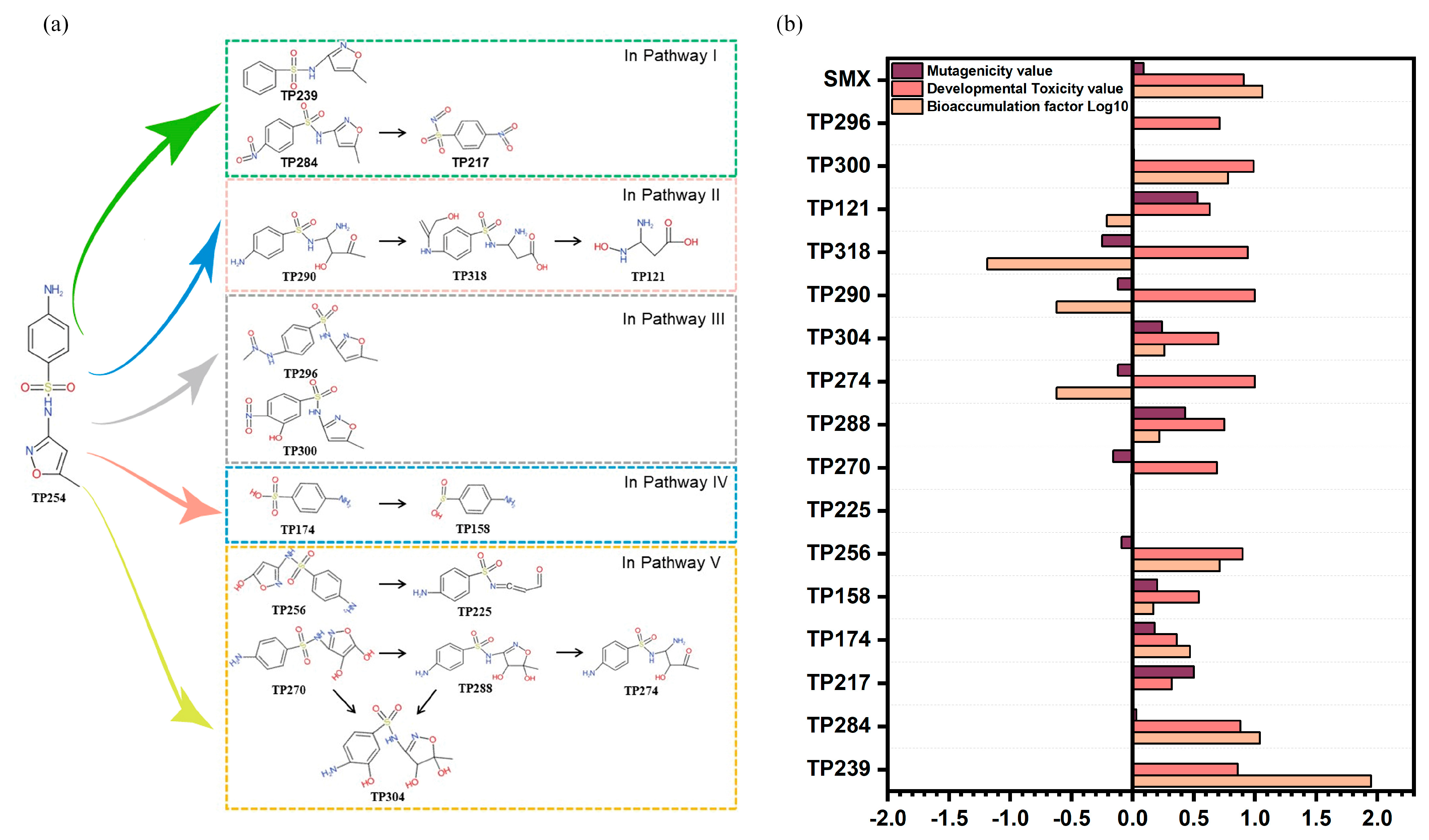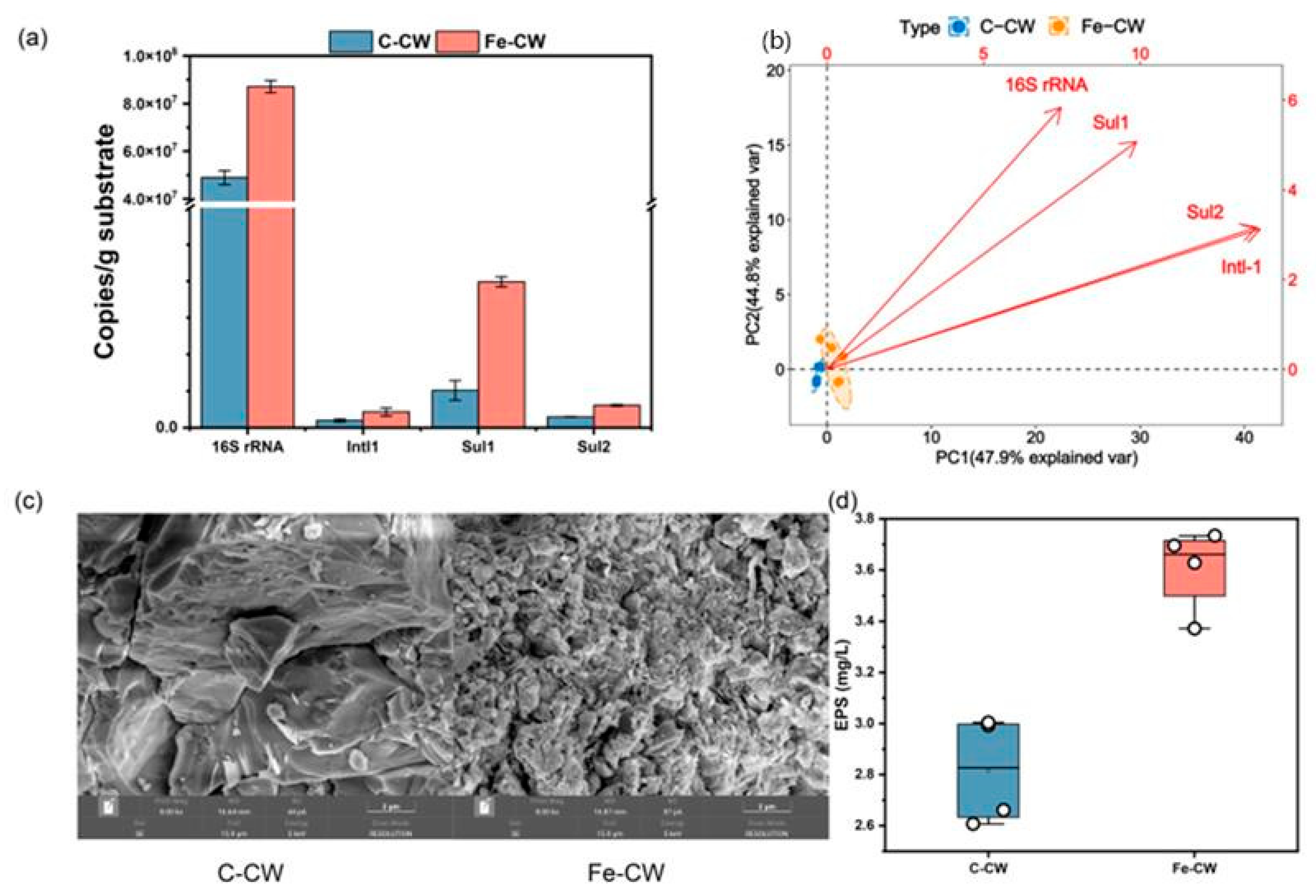The Dual Effect of Hematite-Amended Constructed Wetlands: Reducing the Toxicity of SMX Degradation Products and Increasing the Dissemination of Antibiotic Resistance Genes
Abstract
Highlights
- Hematite enhanced the SMX removal while promoting the ARGs dissemination.
- Hematite increases the SMX degradation pathway and reduced intermediate toxicity.
- Hematite promotes the SMX removal by altering the microbial community structure, while simultaneously enhancing cell-cell adhesion, thereby facilitating the ARGs dissemination.
- While hematite may alleviate the SMX toxicity, the long-term ecological risks associated with its presence warrant further attention.
Abstract
1. Introduction
2. Materials and Methods
2.1. Chemicals and Materials
2.2. Experimental Setup and Operation
2.3. Characterization of Substrate
2.4. Measurement of Extracellular Polymeric Substance (EPS)
2.5. Microbial Analysis
2.6. Determination of Antibiotics
2.7. ARG Quantification
2.8. Statistical Analysis
3. Results and Discussion
3.1. Hematite-Amended CWs Improved SMX Removal
3.2. Potential Degradation Pathways of SMX and Toxicity Assessment of Intermediate Byproducts
3.3. ARG Dissemination
4. Conclusions
Supplementary Materials
Author Contributions
Funding
Data Availability Statement
Conflicts of Interest
References
- Baran, W.; Adamek, E.; Ziemiańska, J.; Sobczak, A. Effects of the presence of sulfonamides in the environment and their influence on human health. J. Hazard. Mater. 2011, 196, 1–15. [Google Scholar] [CrossRef]
- Xue, W.; Li, F.; Zhou, Q. Degradation mechanisms of sulfamethoxazole and its induction of bacterial community changes and antibiotic resistance genes in a microbial fuel cell. Bioresour. Technol. 2019, 289, 121632. [Google Scholar] [CrossRef]
- Wang, J.; Wang, S. Microbial degradation of sulfamethoxazole in the environment. Appl. Microbiol. Biotechnol. 2018, 102, 3573–3582. [Google Scholar] [CrossRef]
- Zhang, Q.-Q.; Ying, G.-G.; Pan, C.-G.; Liu, Y.-S.; Zhao, J.-L. Comprehensive evaluation of antibiotics emission and fate in the river basins of China: Source analysis, multimedia modeling, and linkage to bacterial resistance. Environ. Sci. Technol. 2015, 49, 6772–6782. [Google Scholar] [CrossRef]
- Batt, A.L.; Kim, S.; Aga, D.S. Comparison of the occurrence of antibiotics in four full-scale wastewater treatment plants with varying designs and operations. Chemosphere 2007, 68, 428–435. [Google Scholar] [CrossRef] [PubMed]
- Zhou, J.; Zhang, Z.; Banks, E.; Grover, D.; Jiang, J. Pharmaceutical residues in wastewater treatment works effluents and their impact on receiving river water. J. Hazard. Mater. 2009, 166, 655–661. [Google Scholar] [CrossRef]
- Lin, A.Y.-C.; Tsai, Y.-T. Occurrence of pharmaceuticals in Taiwan’s surface waters: Impact of waste streams from hospitals and pharmaceutical production facilities. Sci. Total Environ. 2009, 407, 3793–3802. [Google Scholar] [CrossRef]
- Zhao, Q.; Guo, W.; Luo, H.; Xing, C.; Wang, H.; Liu, B.; Si, Q.; Ren, N. Deciphering the transfers of antibiotic resistance genes under antibiotic exposure conditions: Driven by functional modules and bacterial community. Water Res. 2021, 205, 117672. [Google Scholar] [CrossRef] [PubMed]
- Wagner, T.V.; Rempe, F.; Hoek, M.; Schuman, E.; Langenhoff, A. Key constructed wetland design features for maximized micropollutant removal from treated municipal wastewater: A literature study based on 16 indicator micropollutants. Water Res. 2023, 244, 120534. [Google Scholar] [CrossRef] [PubMed]
- Cui, E.; Fan, X.; Cui, B.; Li, S.; Chen, T.; Gao, F.; Li, J.; Zhou, Z. The introduction of influent sulfamethoxazole loads induces changes in the removal pathways of sulfamethoxazole in vertical flow constructed wetlands featuring hematite substrate. J. Hazard. Mater. 2024, 469, 133964. [Google Scholar] [CrossRef]
- Xu, Y.; Liu, Y.; Zhang, B.; Bu, C.; Wang, Y.; Zhang, D.; Xi, M.; Qin, Q. Enhanced removal of sulfamethoxazole and tetracycline in bioretention cells amended with activated carbon and zero-valent iron: System performance and microbial community. Sci. Total Environ. 2021, 797, 148992. [Google Scholar] [CrossRef]
- Chen, J.; Wei, X.-D.; Liu, Y.-S.; Ying, G.-G.; Liu, S.-S.; He, L.-Y.; Su, H.-C.; Hu, L.-X.; Chen, F.-R.; Yang, Y.-Q. Removal of antibiotics and antibiotic resistance genes from domestic sewage by constructed wetlands: Optimization of wetland substrates and hydraulic loading. Sci. Total Environ. 2016, 565, 240–248. [Google Scholar] [CrossRef]
- Xu, G.; Li, Y.; Hou, W.; Wang, S.; Kong, F. Effects of substrate type on enhancing pollutant removal performance and reducing greenhouse gas emission in vertical subsurface flow constructed wetland. J. Environ. Manag. 2021, 280, 111674. [Google Scholar] [CrossRef]
- Lu, J.; Guo, Z.; Pan, Y.; Li, M.; Chen, X.; He, M.; Wu, H.; Zhang, J. Simultaneously enhanced removal of PAHs and nitrogen driven by Fe2+/Fe3+ cycle in constructed wetland through automatic tidal operation. Water Res. 2022, 215, 118232. [Google Scholar] [CrossRef]
- Zhang, X.; Li, C.; Yao, D.; Hu, X.; Xie, H.; Hu, Z.; Liang, S.; Zhang, J. The environmental risk assessment of constructed wetlands filled with iron and manganese ores in typical antibiotic treatment. Environ. Res. 2024, 240, 117567. [Google Scholar] [CrossRef] [PubMed]
- Xu, D.; Li, B.; Dou, X.; Feng, L.; Zhang, L.; Liu, Y. Enhanced performance and mechanisms of sulfamethoxazole removal in vertical subsurface flow constructed wetland by filling manganese ore as the substrate. Sci. Total Environ. 2022, 812, 152554. [Google Scholar] [CrossRef]
- Zhang, G.; Hao, Q.; Ma, R.; Luo, S.; Chen, K.; Liang, Z.; Jiang, C. Biochar and hematite amendments suppress emission of CH4 and NO2 in constructed wetlands. Sci. Total Environ. 2023, 874, 162451. [Google Scholar] [CrossRef]
- Tai, Y.; Tam, N.F.-Y.; Wang, R.; Yang, Y.; Lin, J.; Wang, J.; Yang, Y.; Li, L.; Sun, Y. Iron plaque formation on wetland-plant roots accelerates removal of water-borne antibiotics. Plant Soil 2018, 433, 323–338. [Google Scholar] [CrossRef]
- Sand-Jensen, K.; Møller, C.L.; Raun, A.L. Outstanding Lobelia dortmanna in iron armour. Plant Signal. Behav. 2008, 3, 882–884. [Google Scholar] [CrossRef] [PubMed]
- Li, Y.; Feng, W.; Chi, H.; Huang, Y.; Ruan, D.; Chao, Y.; Qiu, R.; Wang, S. Could the rhizoplane biofilm of wetland plants lead to rhizospheric heavy metal precipitation and iron-sulfur cycle termination? J. Soils Sediments 2019, 19, 3760–3772. [Google Scholar] [CrossRef]
- Peng, C.; Chen, S.; Shen, C.; He, M.; Zhang, Y.; Ye, J.; Liu, J.; Shi, J. Iron plaque: A barrier layer to the uptake and translocation of copper oxide nanoparticles by rice plants. Environ. Sci. Technol. 2018, 52, 12244–12254. [Google Scholar] [CrossRef]
- Yue, J.; Hu, X.; Xie, H.; Sun, B.; Hu, Z.; Zhang, J.; Zhong, Y. Enhancing emerging pollutant removal mediated by root iron plaques: Integrated abiotic and biotic effects. J. Hazard. Mater. 2025, 485, 136900. [Google Scholar] [CrossRef]
- Pan, L.-J.; Li, J.; Li, C.-X.; Tang, X.-D.; Yu, G.-W.; Wang, Y. Study of ciprofloxacin biodegradation by a Thermus sp. isolated from pharmaceutical sludge. J. Hazard. Mater. 2018, 343, 59–67. [Google Scholar] [CrossRef]
- Peng, Y.; Xie, G.; Shao, P.; Ren, W.; Li, M.; Hu, Y.; Yang, L.; Shi, H.; Luo, X. A comparison of SMX degradation by persulfate activated with different nanocarbons: Kinetics, transformation pathways, and toxicity. Appl. Catal. B Environ. 2022, 310, 121345. [Google Scholar] [CrossRef]
- Tian, Y.; Lu, X.; Hou, J.; Xu, J.; Zhu, L.; Lin, D. Application of α-Fe2O3 nanoparticles in controlling antibiotic resistance gene transport and interception in porous media. Sci. Total Environ. 2022, 834, 155271. [Google Scholar] [CrossRef] [PubMed]
- Fan, Y.; Sun, S.; He, S. Iron plaque formation and its effect on key elements cycling in constructed wetlands: Functions and outlooks. Water Res. 2023, 235, 119837. [Google Scholar] [CrossRef] [PubMed]
- Yi, L.; Zhang, W.; Li, H.; Lu, Y.; Liu, J.; Tao, S.; Alvarez, P.J.; Zhu, D. Microbial dissimilatory iron reduction facilitates release and horizontal transfer of plasmid-borne antibiotic resistance genes adsorbed on hematite. Geochim. Cosmochim. Acta 2024, 383, 70–80. [Google Scholar] [CrossRef]
- Yuan, X.; Cui, K.; Chen, Y.; Wu, S.; Liu, X.; Diao, H. Deciphering the response of biological nitrogen removal to gadolinium and sulfamethoxazole combined pollution: Performance, microbial community, and antibiotic resistance genes. Process Saf. Environ. Prot. 2022, 167, 192–202. [Google Scholar] [CrossRef]
- Inarmal, N.; Moodley, B. Selected pharmaceutical analysis in a wastewater treatment plant during COVID-19 infection waves in South Africa. Environ. Sci. Water Res. Technol. 2023, 9, 1566–1576. [Google Scholar] [CrossRef]
- Wei, C.-H.; Sanchez-Huerta, C.; Leiknes, T.; Amy, G.; Zhou, H.; Hu, X.; Fang, Q.; Rong, H. Removal and biotransformation pathway of antibiotic sulfamethoxazole from municipal wastewater treatment by anaerobic membrane bioreactor. J. Hazard. Mater. 2019, 380, 120894. [Google Scholar] [CrossRef]
- Abegglen, C.; Joss, A.; McArdell, C.S.; Fink, G.; Schlüsener, M.P.; Ternes, T.A.; Siegrist, H. The fate of selected micropollutants in a single-house MBR. Water Res. 2009, 43, 2036–2046. [Google Scholar] [CrossRef] [PubMed]
- Ezzeroug Ezzraimi, A.; Baudoin, J.-P.; Mariotti, A.; Camoin-Jau, L. Microscopic description of platelet aggregates induced by Escherichia coli strains. Cells 2022, 11, 3495. [Google Scholar] [CrossRef]
- Liu, H.; Hu, Z.; Jiang, L.; Zhuang, L.; Hao, L.; Zhang, J.; Nie, L. Roles of carbon source-derived extracellular polymeric substances in solids accumulation and nutrient removal in horizontal subsurface flow constructed wetlands. Chem. Eng. J. 2019, 362, 702–711. [Google Scholar] [CrossRef]
- Hu, X.; Huo, J.; Xie, H.; Hu, Z.; Liang, S.; Zhang, J. Removal performance, biotransformation pathways and products of sulfamethoxazole in vertical subsurface flow constructed wetlands with different substrates. Chemosphere 2023, 313, 137572. [Google Scholar] [CrossRef] [PubMed]
- He, Y.; Sutton, N.B.; Lei, Y.; Rijnaarts, H.H.; Langenhoff, A.A. Fate and distribution of pharmaceutically active compounds in mesocosm constructed wetlands. J. Hazard. Mater. 2018, 357, 198–206. [Google Scholar] [CrossRef] [PubMed]
- Hu, X.; Xie, H.; Zhuang, L.; Zhang, J.; Hu, Z.; Liang, S.; Feng, K. A review on the role of plant in pharmaceuticals and personal care products (PPCPs) removal in constructed wetlands. Sci. Total Environ. 2021, 780, 146637. [Google Scholar] [CrossRef]
- Ricken, B.; Corvini, P.F.; Cichocka, D.; Parisi, M.; Lenz, M.; Wyss, D.; Martínez-Lavanchy, P.M.; Müller, J.A.; Shahgaldian, P.; Tulli, L.G. Ipso-hydroxylation and subsequent fragmentation: A novel microbial strategy to eliminate sulfonamide antibiotics. Appl. Environ. Microbiol. 2013, 79, 5550–5558. [Google Scholar] [CrossRef]
- Ji, J.; Zhu, Q.; Yang, X.; Wang, C. Review of biodegradation of sulfonamide antibiotics influenced by dissolved organic matter and iron oxides. J. Environ. Chem. Eng. 2023, 11, 111020. [Google Scholar] [CrossRef]
- Peng, Q.-a.; Shaaban, M.; Wu, Y.; Hu, R.; Wang, B.; Wang, J. The diversity of iron reducing bacteria communities in subtropical paddy soils of China. Appl. Soil Ecol. 2016, 101, 20–27. [Google Scholar] [CrossRef]
- Deng, S.; Peng, S.; Ngo, H.H.; Oh, S.J.-A.; Hu, Z.; Yao, H.; Li, D. Characterization of nitrous oxide and nitrite accumulation during iron (Fe (0))-and ferrous iron (Fe (II))-driven autotrophic denitrification: Mechanisms, environmental impact factors and molecular microbial characterization. Chem. Eng. J. 2022, 438, 135627. [Google Scholar] [CrossRef]
- Antenozio, M.; Giannelli, G.; Marabottini, R.; Brunetti, P.; Allevato, E.; Marzi, D.; Capobianco, G.; Bonifazi, G.; Serranti, S.; Visioli, G. Phytoextraction efficiency of Pteris vittata grown on a naturally As-rich soil and characterization of As-resistant rhizosphere bacteria. Sci. Rep. 2021, 11, 6794. [Google Scholar] [CrossRef] [PubMed]
- Wu, S.; Ren, P.; Wu, Y.; Liu, J.; Huang, Q.; Cai, P. Effects of hematite on the dissemination of antibiotic resistance in pathogens and underlying mechanisms. J. Hazard. Mater. 2022, 431, 128537. [Google Scholar] [CrossRef] [PubMed]
- Liu, X.; Lu, S.; Liu, Y.; Wang, Y.; Guo, X.; Chen, Y.; Zhang, J.; Wu, F. Performance and mechanism of sulfamethoxazole removal in different bioelectrochemical technology-integrated constructed wetlands. Water Res. 2021, 207, 117814. [Google Scholar] [CrossRef] [PubMed]
- Gong, H.; Chu, W.; Xu, K.; Xia, X.; Gong, H.; Tan, Y.; Pu, S. Efficient degradation, mineralization and toxicity reduction of sulfamethoxazole under photo-activation of peroxymonosulfate by ferrate (VI). Chem. Eng. J. 2020, 389, 124084. [Google Scholar] [CrossRef]
- Su, T.; Deng, H.; Benskin, J.P.; Radke, M. Biodegradation of sulfamethoxazole photo-transformation products in a water/sediment test. Chemosphere 2016, 148, 518–525. [Google Scholar] [CrossRef]
- Solar, S.; Solar, W.; Getoff, N. Resolved multisite OH-attack on aqueous aniline studied by pulse radiolysis. Int. J. Radiat. Appl. Instrumentation. Part C. Radiat. Phys. Chem. 1986, 28, 229–234. [Google Scholar] [CrossRef]
- Yang, Y.; Lu, X.; Jiang, J.; Ma, J.; Liu, G.; Cao, Y.; Liu, W.; Li, J.; Pang, S.; Kong, X. Degradation of sulfamethoxazole by UV, UV/H2O2 and UV/persulfate (PDS): Formation of oxidation products and effect of bicarbonate. Water Res. 2017, 118, 196–207. [Google Scholar] [CrossRef]
- Zhou, L.-J.; Han, P.; Yu, Y.; Wang, B.; Men, Y.; Wagner, M.; Wu, Q.L. Cometabolic biotransformation and microbial-mediated abiotic transformation of sulfonamides by three ammonia oxidizers. Water Res. 2019, 159, 444–453. [Google Scholar] [CrossRef]
- Kassotaki, E.; Buttiglieri, G.; Ferrando-Climent, L.; Rodriguez-Roda, I.; Pijuan, M. Enhanced sulfamethoxazole degradation through ammonia oxidizing bacteria co-metabolism and fate of transformation products. Water Res. 2016, 94, 111–119. [Google Scholar] [CrossRef]
- Tang, T.; Liu, M.; Chen, Y.; Du, Y.; Feng, J.; Feng, H. Influence of sulfamethoxazole on anaerobic digestion: Methanogenesis, degradation mechanism and toxicity evolution. J. Hazard. Mater. 2022, 431, 128540. [Google Scholar] [CrossRef]
- Meunier, B.; De Visser, S.P.; Shaik, S. Mechanism of oxidation reactions catalyzed by cytochrome P450 enzymes. Chem. Rev. 2004, 104, 3947–3980. [Google Scholar] [CrossRef]
- Shaik, S.; Kumar, D.; de Visser, S.P.; Altun, A.; Thiel, W. Theoretical perspective on the structure and mechanism of cytochrome P450 enzymes. Chem. Rev. 2005, 105, 2279–2328. [Google Scholar] [CrossRef]
- He, Y.; Yin, X.; Li, F.; Wu, B.; Zhu, L.; Ge, D.; Wang, N.; Chen, A.; Zhang, L.; Yan, B. Response characteristics of antibiotic resistance genes and bacterial communities during agricultural waste composting: Focusing on biogas residue combined with biochar amendments. Bioresour. Technol. 2023, 372, 128636. [Google Scholar] [CrossRef]
- Subirats, J.; Timoner, X.; Sànchez-Melsió, A.; Balcázar, J.L.; Acuña, V.; Sabater, S.; Borrego, C.M. Emerging contaminants and nutrients synergistically affect the spread of class 1 integron-integrase (intI1) and sul1 genes within stable streambed bacterial communities. Water Res. 2018, 138, 77–85. [Google Scholar] [CrossRef] [PubMed]
- Shah, S.Q.; Cabello, F.C.; L’Abée-Lund, T.M.; Tomova, A.; Godfrey, H.P.; Buschmann, A.H.; Sørum, H. Antimicrobial resistance and antimicrobial resistance genes in marine bacteria from salmon aquaculture and non-aquaculture sites. Environ. Microbiol. 2014, 16, 1310–1320. [Google Scholar] [CrossRef] [PubMed]
- Wang, H.; Hou, L.; Liu, Y.; Liu, K.; Zhang, L.; Huang, F.; Wang, L.; Rashid, A.; Hu, A.; Yu, C. Horizontal and vertical gene transfer drive sediment antibiotic resistome in an urban lagoon system. J. Environ. Sci. 2021, 102, 11–23. [Google Scholar] [CrossRef]
- Hu, A.; Wang, H.; Li, J.; Mulla, S.I.; Qiu, Q.; Tang, L.; Rashid, A.; Wu, Y.; Sun, Q.; Yu, C.-P. Homogeneous selection drives antibiotic resistome in two adjacent sub-watersheds, China. J. Hazard. Mater. 2020, 398, 122820. [Google Scholar] [CrossRef] [PubMed]
- Chen, Y.; Su, J.-Q.; Zhang, J.; Li, P.; Chen, H.; Zhang, B.; Gin, K.Y.-H.; He, Y. High-throughput profiling of antibiotic resistance gene dynamic in a drinking water river-reservoir system. Water Res. 2019, 149, 179–189. [Google Scholar] [CrossRef]
- Frølund, B.; Palmgren, R.; Keiding, K.; Nielsen, P.H. Extraction of extracellular polymers from activated sludge using a cation exchange resin. Water Res. 1996, 30, 1749–1758. [Google Scholar] [CrossRef]
- Schmidt, M.P.; Martinez, C.E. Ironing out genes in the environment: An experimental study of the DNA–goethite interface. Langmuir 2017, 33, 8525–8532. [Google Scholar] [CrossRef]






Disclaimer/Publisher’s Note: The statements, opinions and data contained in all publications are solely those of the individual author(s) and contributor(s) and not of MDPI and/or the editor(s). MDPI and/or the editor(s) disclaim responsibility for any injury to people or property resulting from any ideas, methods, instructions or products referred to in the content. |
© 2025 by the authors. Licensee MDPI, Basel, Switzerland. This article is an open access article distributed under the terms and conditions of the Creative Commons Attribution (CC BY) license (https://creativecommons.org/licenses/by/4.0/).
Share and Cite
Zhang, S.; Zhang, X.; Sun, F.; Li, C.; Hu, Z.; Liang, S.; Xie, H. The Dual Effect of Hematite-Amended Constructed Wetlands: Reducing the Toxicity of SMX Degradation Products and Increasing the Dissemination of Antibiotic Resistance Genes. Water 2025, 17, 2850. https://doi.org/10.3390/w17192850
Zhang S, Zhang X, Sun F, Li C, Hu Z, Liang S, Xie H. The Dual Effect of Hematite-Amended Constructed Wetlands: Reducing the Toxicity of SMX Degradation Products and Increasing the Dissemination of Antibiotic Resistance Genes. Water. 2025; 17(19):2850. https://doi.org/10.3390/w17192850
Chicago/Turabian StyleZhang, Shiwen, Xin Zhang, Fengkai Sun, Chaoyu Li, Zhen Hu, Shuang Liang, and Huijun Xie. 2025. "The Dual Effect of Hematite-Amended Constructed Wetlands: Reducing the Toxicity of SMX Degradation Products and Increasing the Dissemination of Antibiotic Resistance Genes" Water 17, no. 19: 2850. https://doi.org/10.3390/w17192850
APA StyleZhang, S., Zhang, X., Sun, F., Li, C., Hu, Z., Liang, S., & Xie, H. (2025). The Dual Effect of Hematite-Amended Constructed Wetlands: Reducing the Toxicity of SMX Degradation Products and Increasing the Dissemination of Antibiotic Resistance Genes. Water, 17(19), 2850. https://doi.org/10.3390/w17192850






